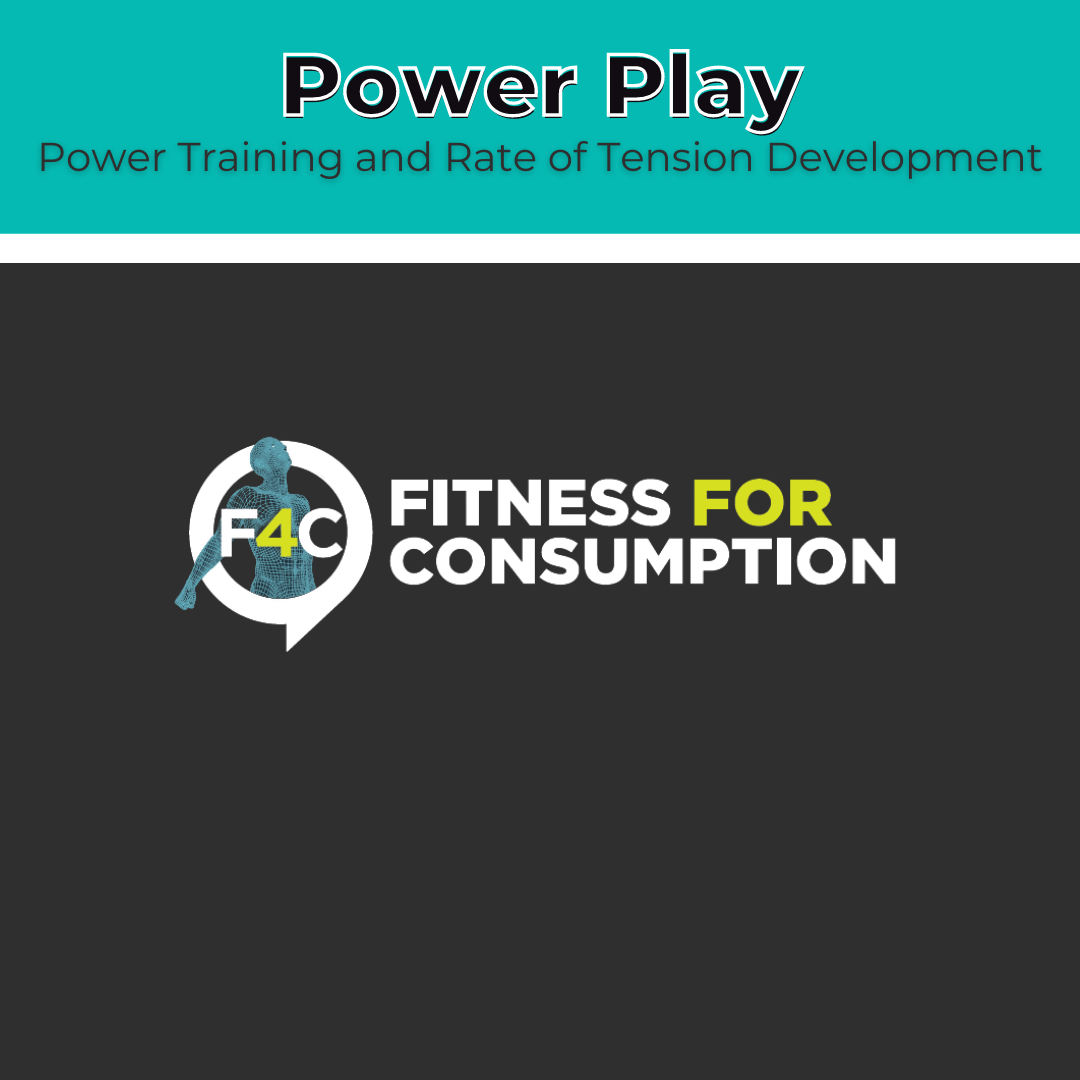Power Play

We say “Power” training you say: ___________? Power training, what sort of images does that conjure? Little old ladies stepping off a curb or giant hulks performing snatches and cleans? If you think snatches and cleans you’d be right. But, if you think little old ladies stepping off of a curb, you’d also be right. Because power training is not about a specific set of exercises, it’s ultimately about load, acceleration and intention.
In this episode, “Power Play,” we once again separate the supposed from the science, like mistakenly relating human power output to the watts displayed on cardio machines, or that moving faster doesn’t mean we’re generating more power. Dr. J and GG explain why there’s a difference and why it matters.
And if power is a product of stimulating fast twitch muscle fibers, how is that measured? What do electromyography (EMG) studies tell us about how we recruit different motor units? What’s a motor unit you ask? Good question, and an important one at that. Not to worry, Dr. J and GG provide a simplified explanation.
Finally, the duo gets to what really matters; what we can do in the gym, at home, or anywhere to improve our power. But in typical Fitness For Consumption style, the solutions are more diverse than you may have originally thought. Lifting heavy weights? Sure. Lifting light weights? Sure. Walking, leaping, hopping, skipping? Sure. But using these tools that are already in your Fitness Eco-System™ effectively, for developing power, is all in the details and the details are in the episode, so give it a listen and let us know what you think!
In this episode we discuss:
- Power training is not a specific type of exercise
- Power training is primarily about Rate of Tension Development (ROTD)
- Difference between velocity and acceleration and why that matters for power training
- What happens in our neuromuscular system when we intend to move rapidly
- What happens in our neuromuscular system when we intend to move slowly
- Why using heavy load is good for developing power
- Why using light load is good for developing power
- Why using no load and no movement is good for developing power
- Why using no load and no movement is limited in it’s functional transfer for developing power
Glossary:
Acceleration - the rate of change of velocity, or velocity divided by time
Joule - International Systems of Units (SI) measure of work. One Joule is equal to the work done by a force of one newton acting through one meter
Motor Unit - a single motor neuron and all of the muscle fibers that it innervates
Power - the rate at which work is done, or force times distance, divided by time
Rate of tension development (ROTD) - time course over which the neuromuscular system produces muscular tension
Velocity - the rate of change of displacement, or displacement divided by time
Watt - a unit of measure of power, defined as pound-feet per second
Work - force times distance
References:
- Behm, D. (1995). Neuromuscular implications and applications of resistance training.Journal of Strength and Conditioning Research. 9(4): 264-274
- Enoka, R. (1994). Neuromechanical Basis of Kinesiology. Second Edition. Human Kinetics. Champaign, IL. p159
- Enoka, R. (1996). Eccentric contractions require unique activation strategies by the nervous system. Journal of Applied Physiology. 81(6): 2339-2346.
- Fielding, R.A., LeBrasseur, N.K., Cuoco, A, et al. (2002). High-velocity resistance training increases skeletal muscle peak power in older women. Journal of the American Geriatrics Society. 50(4): 655-662.
- Hannaford, B. and Lehman, S. (1986). Short time fourier analysis of the electromyogram: fast movements and constant contraction. EEE Transactions on Biomedical Engineering. BME-33(12): 1173-1181.
- Kaneko, M. (1974). The Dynamics of Human Muscle. Kyorinshoin Book Company, Tokyo.
- Komi, P.V. and Viitasalo, J.H.T. (1976). Signal characteristics of EMG at different levels of muscle tension. Acta Physiologica Scandinavia. 96: 267-276.
- Komi, P.V., Viitasalo, J.H.T., Rauramaa, R., and Vihko, V. (1978). Effect of isometric strength training on mechanical, electrical and metabolic aspects of muscle function. European Journal of Applied Physiology. 40: 45-55.
- Kranz, H., Williams, A.M., Cassell,J. et.al. (1983). Factors determining the frequency content of the electromyogram. Journal of Applied Physiology. 55(2): 392-399
- Loeb, G.E., (1985) Motoneurone task groups: Coping with Kinematic Heterogeneity. J Exp Biol. 115, 137-146
- Milner-Brown, H.S., Stein, R.B., and Lee, R.G. (1975). Synchronization of human motor units: possible roles of exercise and supraspinal reflexes. Electroencephalography and Clinical Neurophysiology. 38: 245-254.
- Moritani, T. (1993). Neuromuscular adaptations during the acquisition of muscle strength power and motor tasks. Journal of Biomechanics. 26(s1): 95-107
- Richardson, D.L., Duncan, M.J., Jiminez, A., et al. (2018). The perceptual responses to high-velocity, low-load and low-velocity, high-load resistance exercise in older adults. Journal of Sport Sciences. 36(14):1594-1601.
You might also like:
Season 1, Episode 2 - Why we move Part 2 - The Fitness Eco-system™
Season 1, Episode 8 - You’ve Got Nerve
Season 2, Episode 1 - I feel the Earth Move
Season 2, Episode 2 - The Fine Print - What’s it all about?
ADVERTISE WITH US: Reach dedicated exercise professionals, future trainers, and exercise enthusiasts all over the world. Send us an email to get the conversation started, hello@thinkfitbefitpodcast.com
SUBSCRIBE TO THE NEWSLETTER: Dive deeper with us. Sign up here. We offer a unique view on muscles, portals to new ways to respect the body and health. Learning and ‘enjoy the process’ is a buzzy term. We take learning seriously and want to take our listeners on that journey with us and through us
SUBSCRIBE: Subscribe to the podcast to make sure you never miss an episode. .
You can find us on a variety of podcast apps:
WRITE A REVIEW: Leave us a rating and a written review on iTunes so more listeners can find us.
JOIN THE CONVERSATION: If you have a question or a topic you want us to address, send us an email here. You can also connect to us through Twitter, Facebook, and Instagram. Tag #thinkfitbefit for a chance to be featured!
NEW TO THE SHOW? Don't be afraid to start with the trailer or one of our recap episodes
Recap Season 1 of Fitness for Consumption part 1
Recap Season 1 of Fitness for Consumption part 2
SUPPORT THE SHOW: by checking out LADDER SPORT, a line of high performance nutritional supplements created by Lebron James and his trainer. They are high quality and NSF certified. Use the code BEFIT10 for a special discount!
HOSTS AND GUESTS can be found at:
https://www.instagram.com/fitnessforconsumption/


